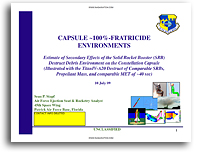USAF 45th Space Wing Study: Capsule~100%-Fratricide Environments (Implications for NASA’s Ares-1 and Crew)

Estimate of Secondary Effects of the Solid Rocket Booster (SRB) Destruct Debris Environment on the Constellation Capsule
(Illustrated with the Titan IV-A20 Destruct of Comparable SRBs, Propellant Mass, and comparable MET of ~40 sec)
UNCLASSIFIED
Sean P. Stapf
Air Force Ejection Seat & Rocketry Analyst
45th Space Wing
Patrick Air Force Base, Florida
QUICK SUMMARY of RESULTS:
A) FRAG VELOCITY DISTRIBUTION. Propellant fragments expand…
– as a spherical “shell” (i.e. of comparable velocity magnitudes – leaving little distribution of propellant fragments within, or beyond, the “shell”)
– At fairly “tight” ranges, from approximately 300-500 fps (some outliers, each side), with betas from ~20-700 lbm/sqft.
– Mass and count distributions comparable to the “FRAG” program, generated from studies such as the joint NASA/DOE/INSRP Explosion Working Group on the Titan 34D-9 and Challenger 51L.
B) CAPSULE ~100% FRATRICIDE by SECONDARY RADIATIVE WILTING of NYLON CHUTES The capsule will not survive an abort between MET’s of ~30 and 60 seconds – as the capsule is engulfed until water-impact by solid propellant fragments radiating heat from 4,000F toward the nylon parachute material (with a melt-temperature of ~400F).
PURPOSE:
a) Re-Confirm Codes. Re-confirm predictive codes & values for solid propellant motor fragmentation, comparing results of the late-1980’s joint NASA/DOE/INSRP Explosion Working Group (and related) analyses of solid propellant rocket debris (particularly applied to the Titan and NASA SRB’s), and verifying that code accuracy continues into the later 1998 Titan A20 destruct at MET=40s.
b) Illustrate Capsule Abort Environment. Illustrate the effect of this solid propellant debris on the Constellation Capsule (particularly the thermalradiative temperature environment of ~4000F while attempting to recover the capsule by deployment of 400F-tolerant nylon parachutes – showing the “probability of hit” is not an indicator of fratricide. A Ph>0 indicates capsule has failed to egress the debris cloud, then thermal induces the Loss of Crew).
c) Velocity Distribution. Suggest values for a “distribution” of predicted uncertainty in debris velocities. Suggest the “credibility” of using velocity variability to justify capsule survival by the variability’s “off-max” lowering of a probability of hit (Ph).
CONCLUSIONS:
* The 45th-Space Wing has reasonable assessments for solid propellant debris fragment masses, velocities, etc.
* The Ares-1 capsule, with an LAS, will 25 not survive an abort between MET’s of ~30-60 seconds.
(High-Q is a risk from ~20-75 sec)








